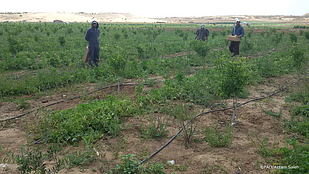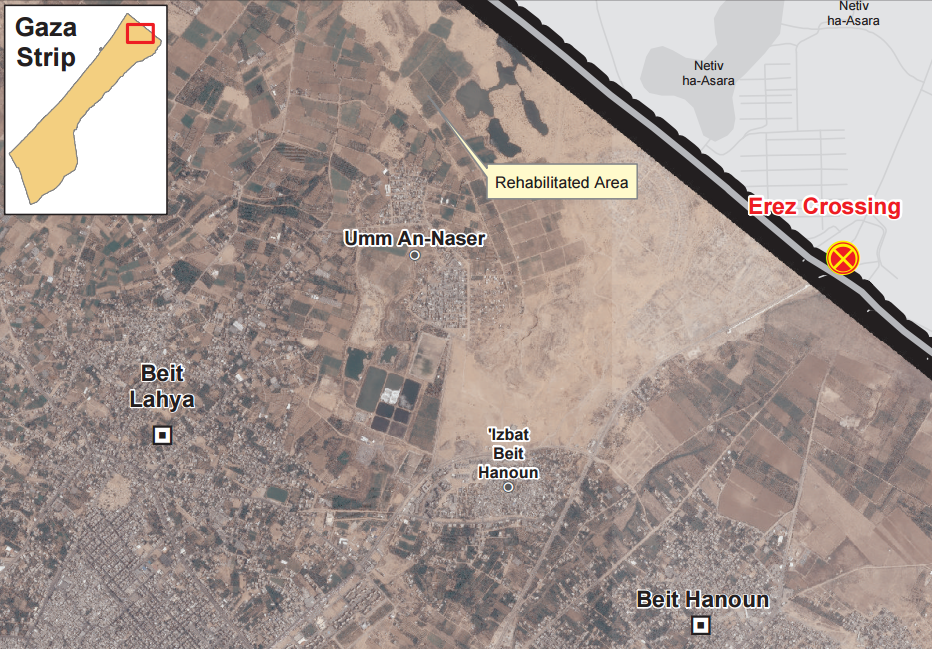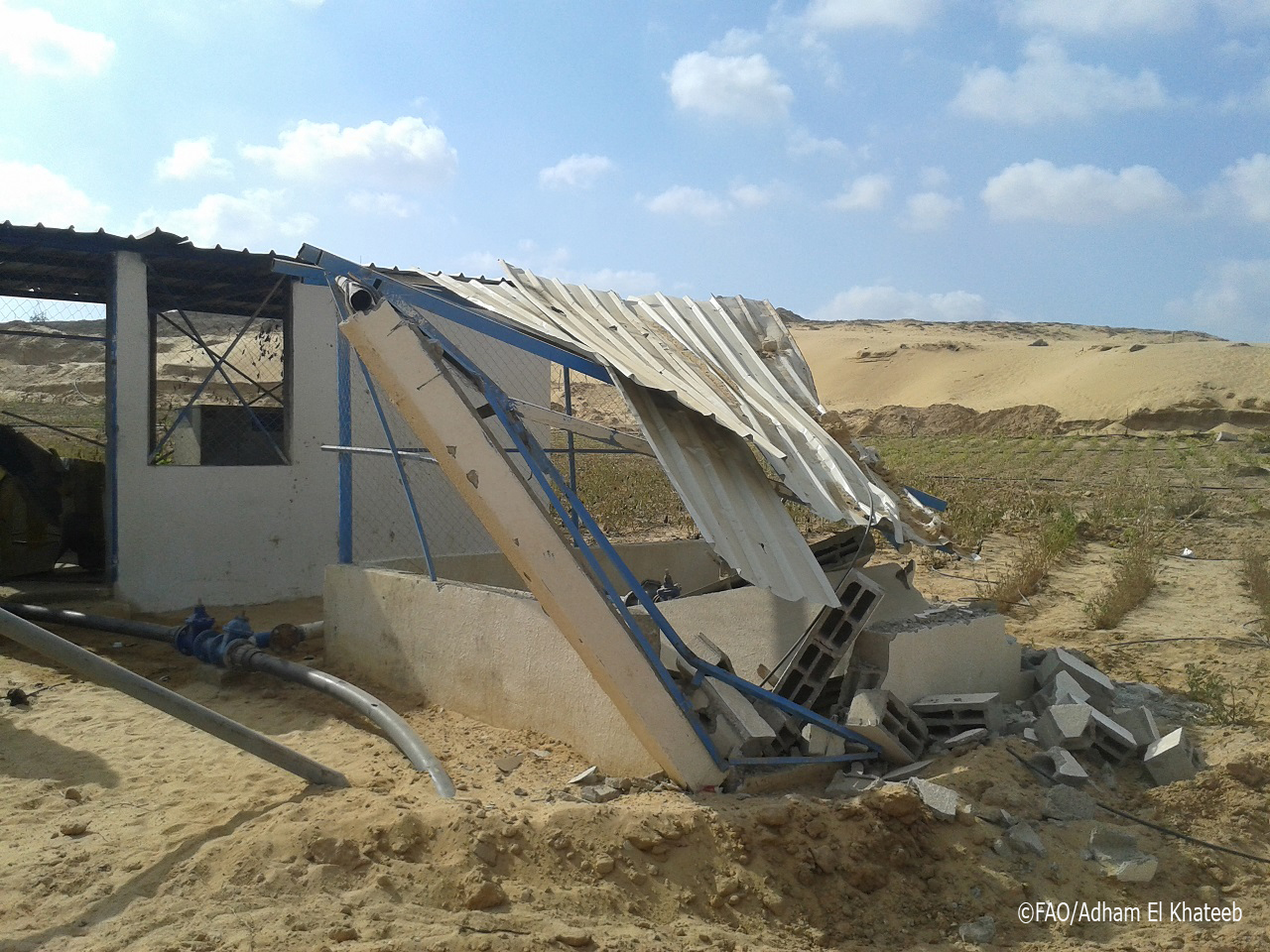Um an Naser: Opportunities for ‘building back better’ in the Access Restricted Areas, Gaza Strip
Interventions to repair agricultural damage from the summer 2014 conflict resulted in a successful harvest
 Amidst ongoing access restrictions and insecurity, and despite significant damage sustained during the 2014 July-August hostilities, Palestinian farmers in the Bedouin village of Um an Naser in northern Gaza managed to complete a successful harvest. This was possible, to a large extent, due to sustained support by humanitarian and development agencies and donors, led by the UN Food and Agriculture Organization (FAO).
Amidst ongoing access restrictions and insecurity, and despite significant damage sustained during the 2014 July-August hostilities, Palestinian farmers in the Bedouin village of Um an Naser in northern Gaza managed to complete a successful harvest. This was possible, to a large extent, due to sustained support by humanitarian and development agencies and donors, led by the UN Food and Agriculture Organization (FAO).
Um an Naser is located in the Access Restricted Area (ARA) near Gaza’s perimeter fence in Beit Lahiya governorate. It is home to approximately 5,000 people and is one of the poorest and most marginalized communities in the Gaza Strip. The village was established in 1997 following the Palestinian Authority’s dispalcement of Bedouin families from Arab Maslakh and the surrounding area (next to Beit Lahiya) to make way for a housing project. In 2009 the de facto authorities in the Gaza Strip designated 1,000 dunums of public land north of the village for community use, allocating two dunums per family, but the community’s ability to cultivate the land remained extremely limited due to access restrictions imposed by the Israeli military.
Since 2012, through strong coordination with all relevant stakeholders, FAO has been able to ensure consistent and safe access to agricultural sites as well as local ownership of project investments in Um an Naser. In November of that year, with the support of the Government of the Netherlands, FAO launched a project aimed at assisting the reclamation and planting of earmarked parcels of land, making 271 dunums of land suitable for agricultural use and providing 125 farmer households with access to sustainable livelihoods, including the planting of melons, squash, cucumbers and eggplant. Subsequently, with the support of the Government of Japan, an agricultural well was established to improve water access for farmers, while Spanish funds secured in-kind agricultural inputs to maximize harvest efficiency.
The 2014 July-August hostilities took a heavy toll on the agricultural sector in Gaza, with damage estimated at $500 million by the Palestinian Ministry of Agriculture. Hostilities damaged 120 dunums of cultivated land, sub-pipelines of drip irrigation networks and the agricultural well, thereby preventing farmers from using significant areas of their land and negatively impacting their income.
With financial support from the Government of the Netherlands, FAO facilitated recovery through the rehabilitation of damaged land and infrastructure, including the repair or replacement of irrigation systems, an agricultural road and rehabilitation of an agricultural well and its generator room – valued at more than $40,000. By January 2015, farmers were able plant their fields, leading to a successful spring harvest.
Despite the significant impact of the blockade and recurrent hostilities on the ARA, the rehabilitation of land in Um an Naser has contributed to the resilience and livelihoods of small-scale farmers, turning abandoned land into an agriculturally productive asset. As such, it sets a precedent for further investment in the ARA, as well as the need for donor support and robust, multi-stakeholder coordination to make this possible.
FAO’s assessments suggest that to fully utilize the 21,640 dunums of arable land located 300 to 1,500 metres from the perimeter fence through land rehabilitation, a water access infrastructure and an optimal cropping pattern, would require an initial investment of $55 million. This could generate an annual gross income of $79 million within two years – a sum that could transform the livelihoods of more than 6,000 marginalized farmer households, with broader positive impacts on the local economy.
* This article was submitted by FAO
Gaza Strip: Agricultural rehabilitation

What are the Access Restricted Areas?
Citing security concerns, since 2000 Israel has imposed severe restrictions on Palestinian access to land and sea, creating a “buffer zone” known as “access restricted areas” (ARA). Access restrictions on land and at sea continue to undermine the security and livelihoods of tens of thousands of Palestinians in Gaza.
The manner in which the ARA has been enforced has endangered the lives and well-being of those who come within the vicinity of these restricted areas. Access restrictions are enforced through a range of mechanisms that include the use of live fire and the destruction, damage and confiscation of property both on land and at sea.
Fishermen are currently allowed to access less than one third of the fishing areas allocated under the Oslo Accords - 6 out of 20 nautical miles (nm) from the coast. The potential fish catch lost as a result of access restrictions is estimated at more than 1,000 metric tonnes (mt) per year, compared to the equivalent catch before 2000.

Israeli communications regarding the scope of the access restrictions imposed on land have been inconsistent. While the area first enforced by Israel in 2000 was 150 metres inside Gaza, this was extended to 300 metres in May 2009. In practice, at various points in time, the “no-go zone’’ on land has been enforced up to 500 metres from the fence, with a “high risk” zone extending up to 1,500 metres. Since the November 2012 ceasefire agreement, access to the ARAs has been eased, allowing some farmers to regularly access their land up to 100 metres from the fence. However, the Israeli authorities have issued contradictory statements regarding accessible areas and applicable conditions, generating further uncertainty and insecurity.
In recent times, the Israeli military has justified the restrictions and measures imposed on the ARA in the vicinity of the fence with reference to concerns about the potential use of these areas by armed factions to dig tunnels into Israel. A number of such tunnels were discovered and destroyed over the course of the July-August hostilities.
Since the beginning of 2014 (excluding the summer hostilities), the majority of casualties on land have occurred in areas within 300 metres of the fence, affecting primarily rubble collectors and demonstrators.
* This section is based on the regular report of human rights concerns in the ARA in Gaza issued by the Office of the United Nations High Commissioner for Human Rights (OHCHR) as coordinator of the Protection Cluster.









